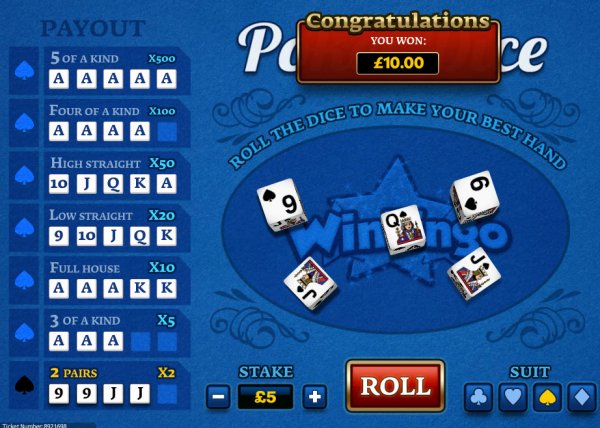


The multinomial coefficient is to partition these five scores into four subgroups, one consisting of one score of 3, one group consisting of two scores of 4, one group consisting of one score of 5 and one group consisting of one score of 6. The first multinomial coefficient above is from a representative outcome, for example, the five scores 3, 4, 4, 5, 6. The following is the number of outcomes for the poker dice hand “one pair”. Thus the probability of “three of a kind” is: Note that the numbers in bold are in the denominator of the second multinomial coefficient above.

Here, we partition the six faces into three groups, one consisting of three faces that do not appear, one consisting two faces (each of which appears once) and one group consisting one face that appears three times. The second multinomial coefficient is from the six scores (faces) of a die. Note that the numbers in bold are in the denominator of the first multinomial coefficient above. We partition the five scores into three subgroups, one consisting the three scores of 1, one consisting the one score of 2 and one consisting the one score of 3. The first multinomial coefficient above is from a representative outcome, for example, the string of scores, 1,1,1,2,3. Then we multiply the two multinomial coefficients: The first application is on the five scores of the poker dice hand and the second is on the six faces of a die. To find the number of outcomes for “three of a kind”, we apply the technique of the double applications of the multinomial coefficients. To find the probability, we simply divide this number of outcomes by. How many of these outcomes satisfy the condition that three distinct scores appear and one of the scores appear three times and each of the other scores appears only once? This is the description of the poker dice hand “three of a kind”. In rolling dice, there are ordered outcomes. The calculation involves a double use of the multinomial coefficients (see the previous post A double application of the multinomial coefficients).
#Poker dice probability how to#
We illustrate how to calculate the probabilities of these poker dice hands.
#Poker dice probability full#
Full house: two distinct scores appear, one score occurs three times and the other score occurs two times (e.g.Four of a kind: two distinct scores appear, one score occurs four times and the other score occurs one time (e.g.Five of a kind: one score occurs five times (e.g.The possible hands are ranked as follows: The resulting five scores from the dice form a poker dice hand. Instead of drawing five cards from a deck of cards, five fair dice are rolled. The game of poker dice is different from the standard poker game. This post presents an application of the multinomial coefficients to the game of poker dice.


 0 kommentar(er)
0 kommentar(er)
